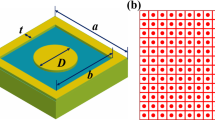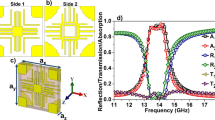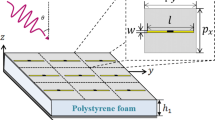Abstract
Metamaterial absorbers have diverse applications in the terahertz range. In this paper, a metallic metamaterial absorber is designed to work as a narrowband, wideband, or ultrawideband according to application. A systematic method with minimal computational requirements for the design is developed. The method is efficient since the only information required is the operating frequency and required bandwidth. A condition for zero reflection which ensures matching with free space is derived. The proposed design method is used for the design of narrowband, wideband, and ultrawideband absorbers. For each case the design parameters are different. The narrow bandwidth is less than 5%, while the wide band lies between 5 and 20%, and the ultrawideband is larger than 20%. The dimensions of the designed structure and material properties (εr″) are different for each case. The designed absorber is wide-angle and polarization-independent. The sensitivity of the designed material due to changes of physical dimensions and permittivity is studied. To validate results, reflectivity and absorptivity are calculated using CST package. The dimensions obtained from the developed method are a bit modified using trial and error. The results from the developed method and CST are in excellent agreement.
Similar content being viewed by others
Introduction
Electromagnetic metamaterial absorbers are very useful to construct active and passive components for imaging from microwave frequencies to visible wavelengths1,2,3. Metamaterial absorbers can be classified into three types4: metallic absorbers, all-dielectric absorbers, and coherent absorbers. At terahertz frequencies, it is difficult to find naturally occurring materials with strong absorption coefficients that are also compatible with standard microfabrication techniques.
In5, a terahertz biosensor based on all-metal metamaterial is proposed. The biosensor uses stainless steel materials manufactured using laser-drilling technology. The unit cell is a hollow-dumb pattern. A temperature-tuneable terahertz perfect absorber composed of a periodic micro-cross-shaped structure of the strontium (STO) titanate resonator is proposed in6. The perfect absorption can also be achieved by using a 3-D square, circular, or ring STO structure. The structure is complicated. A broadband visible perfect absorber using a plasmonic metasurface which consists of a quadrilateral truncated cone configuration is designed in7. The unit cell consists of 4 layers: GaAs, Ti, SiO2, and Cu with complicated geometry. A broadband metamaterial absorber is presented in8. The unit cell is of complicated geometry with loaded four surface-mounted resistors.
Theoretical approaches and algorithms such as impedance matching theory9, reflection theory10, antenna reciprocity theory11, and optimization algorithms12,13, were introduced to analyze broadband absorbers. However, all these theories cannot guide the design of wideband absorbers. They only explain the broadband absorbing mechanism.
In this paper, a metallic metamaterial absorber was designed to operate in the terahertz (1–3 THz) range. The design depends upon the scale-invariant property of Maxwell’s equations with no charges or currents.
Scale invariance is a term used in mathematics, economics, and physics and is a feature of an object that does not change if all scales in the object are multiplied by a constant factor14,15. Maxwell’s equations with no charges or currents are an example of scale invariance. If E(x,t) is a solution of Maxwell’s equations, then E(λx, λt) is also a solution, where λ is a constant.
The novelty in the paper lies in the fact that narrowband absorbers, wideband absorbers, and ultrawideband absorbers can be designed using the same developed design technique. The dimensions and dielectric properties of the designed absorber depend on the bandwidth. The developed design technique is: (1) based on simple mathematical equations, (2) efficient, since the only required information is the operating frequency and bandwidth, and (3) does not require expensive software packages. Just a simple MATLAB program is required. The designed absorber is wide-angle and polarization-independent. Finite integration technique (CST) was used to design narrowband, wideband, and ultrawideband absorbers. There was little difference between the results obtained and those obtained by the developed technique. However, the dimensions obtained by the developed technique were slightly modified and the results obtained were in excellent agreement with those obtained by the finite integral technique.
A microwave metal metamaterial absorber (6–14 GHz) was designed by the authors16. This absorber is scaled up in frequency to operate in the THz band (1–3 THz).
The paper is organized as follows. Section “Theory” includes theory and derivation of condition for zero reflection. A simple procedure for the design of the absorber is developed in section “Design”. Results and Conclusions are given in subsequent sections.
Theory
The absorbing structure is shown in Fig. 1. The dimensions of the structure must be small compared to wavelength.
The input impedance to such structure is given by17:
In deriving Eqs. (1) and (2) it was assumed that w/D ≪ 1. The substrate is a lossy dielectric material. Therefore, the dielectric constant is complex:
θ is the angle of incidence as shown in Fig. 2.
If the dielectric constant εr is chosen to be large, the input impedance of Eqs. (1) and (2) will be independent of θ. This means that the absorbing material is independent of polarization. The input impedance becomes:
This equation can be put in the form:
where
If εr in Eq. (10) is replaced by its value in (6), after some manipulation we have:
Equation (11) can be put in the form:
where:
and:
From (12) into (8) we get (omitting details):
reflection coefficient of the structure is given by:
where η is the intrinsic impedance of free space.
For the structure to work as a perfect absorbing material, there must be matching with free space. This means R must be zero which means Zinp = η (real). The imaginary part of (15) must be zero. Thus:
At this frequency, the input impedance from (15) becomes:
The impedance given by (18) is the maximum value of input impedance. The bandwidth of the input impedance is obtained from:
From which the bandwidth is given by :
Ethics approval
The authors assure that this paper is the authors’ own original work, which has not been previously published elsewhere. The paper is not currently being considered for publication elsewhere. The paper reflects the authors’ own research and analysis in a truthful and complete manner.
Consent to participate
All authors agreed to participate in this research.
Design
From the theory presented above, it is possible to develop a simple procedure to design (find the dimensions of) the absorbing material. The data available is the operating frequency and bandwidth. From Eqs. (17), (18) and (20) we have:
Using the values of g, L, and C together with Eqs. (9), (13), and (14) we get the dimensions of the structure d, D, w, εr′, and εr″. But we need some simplifying assumptions. It was mentioned that w/D must be small. We take w/D to be 0.1. Take εr′ to be large (= 10). Thus we are left with 3 unknowns: d, D, and εr″ with 3 Eqs. (9), (13) and (14). Thus all the dimensions can be found.
Results
Narrowband absorbers are required for spectrally selective absorbers which has potential applications in sensitive detectors and narrowband thermophotovoltaic emitters18. Broadband absorbers are required for energy harvesting: solar-driven steam generation and photodetection via hot electron harvesting19. Here we show results for narrowband and broadband absorbers. Figure 3 shows absorptivity vs. frequency (a), and reflectivity vs. frequency (b) for normal incidence. Table 1 summarizes the properties of different absorbers.
The results of Fig. 3 were validated using CST. Figures 4, 5 and 6 show comparison between results obtained by the developed technique and CST for narrow band, wideband and ultrawide band respectively. The dimensions obtained by the developed technique were modified to get these results.
The maximum bandwidth that can be realized depends upon the dimensions of the structure and the material available. The choice of dimensions depends upon technology of fabrication. Figure 7 shows variation of imaginary part of permittivity, periodicity, and substrate thickness with fractional bandwidth. Increase of fractional bandwidth means increase of substrate thickness and imaginary part of permittivity while periodicity is reduced.
The absorptivity for TE and TM polarizations at different angles of incidence are shown in Fig. 8a,b for ultrawideband absorbers. Figure 9 shows absorptivity for TE and TM ultrawideband absorbers for incident angle (a) 0°, (b) 80°. It can be noticed from the figures that the difference in absorptivity between TE and TM modes is extremely small. Thus the designed absorbers are polarization independent. As the incident angle increases, no change in absorptivity can be noticed except for a very small shift in resonance frequency. The designed absorber is wide angle.
The sensitivity of absorptivity to changes of periodicity (D) and permittivity (εr′) was studied. Figure 10 shows changes of absorptivity due to a 20% change of periodicity. This caused a 12.5% change of resonance frequency. Figure 11 shows changes of absorptivity due to a change of the real part of relative permittivity (εr′) from 8 to 12. The change of absorptivity is very small and can hardly be noticed.
The power imparted per cubic meter of dielectric substrate material from the RF field is: P = 2π εo εr″ f E2 where f is the frequency and E is the electric field. The work suggested in this study is superior to other published studies in terms of wide angle, simple structure, and simple mathematics used. This is indicated in Table (2).
Conclusions
A perfect absorber with absorptivity 100% has been designed at 1.6 THz. The scale invariance property of Maxwell’s equations with no charges or currents was used to scale up a design from microwave to terahertz range. A simple procedure was developed for the design. The results were validated using CST with little modification of the dimensions obtained by the developed procedure. The bandwidth of the absorber can be adjusted through physical parameters of the absorber. The physical parameters of the absorber were obtained for bandwidths 5, 15, and 25%. The results obtained showed that the absorber is wide angle and polarization independent. A 20% change of periodicity (D) caused a 12.5% change of resonance frequency. The change in absorptivity due to change of (εr′) from 8 to 12 was too small to be noticed.
Data availability
The authors affirm that the data underlying the study's conclusions are presented in the article, and the manuscript has no associated data. All data generated or analysed during this study are included in this published article.
References
Fan, K., Suen, J. Y., Liu, X. & Padilla, W. J. All-dielectric metasurface absorbers for uncooled terahertz imaging. Optica 4(6), 601–604 (2017).
Watts, C. M. et al. Terahertz compressive imaging with metamaterial spatial light modulator. Nat. Photonics 8(8), 605–609 (2014).
Shrekenhamer, D., Watts, C. M. & Padilla, W. J. Terahertz single pixel imaging with an optically controlled dynamic spatial light modulator. Opt. Express 21(10), 12507–12518 (2013).
Padilla, W. J. & Fan, K. Metamaterial electromagnetic wave absorbers 1st edn. (Springer Nature, 2022).
Wang, G. et al. All-metal terahertz metamaterial biosensor for protein detection. Nanoscale Res. Lett. 16, 109 (2021).
Zhao, J. & Cheng, Y. Temperature-tunable terahertz perfect absorber based on all-dielectric strontium titanate (STO) resonator structure. Adv. Theor. Simul. 5, 2200520 (2022).
Wang, Y., Chen, K., Lin, Y.-S. & Yang, B.-R. Plasmonic metasurface with quadrilateral truncated cones for visible perfect absorber. Physica E 139, 115140 (2022).
Saadeldin, A. S. et al. Broadband polarization insensitive metamaterial absorber. Opt. Quantum Electron. 55, 652 (2023).
Qu, S. et al. Underwater metamaterial absorber with impedance-matched composite. Sci. Adv. 8(20), eabm4206 (2022).
Xiong, H. et al. Varied absorption peaks of dual-band metamaterial absorber analysis by using reflection theory. Appl. Phys. A 122, 164 (2016).
Lin, X. Q., Mei, P., Zhang, P. C., Chen, Z. Z. D. & Fan, Y. Development of a resistor-loaded ultrawideband absorber with antenna reciprocity. IEEE Trans. Antennas Propag. 64(11), 4910–4913 (2016).
Xiong, H., Yang, Q., Huang, Z.-C., Peng, W.-X. & Zhang, H.-Q. Analyzing broadband tunable metamaterial absorbers by using the symmetry model. Opt. Express 29(25), 41475–41484 (2021).
Suo, M., Xiong, H., Li, X.-K., Liu, Q.-F. & Zhang, H.-Q. A flexible transparent absorber bandwidth expansion design based on characteristic modes. Results Phys. 46, 106265 (2023).
Christov, C. I. On the material invariant formulation of Maxwell’s displacement current. Found. Phys. 36, 1701–1717 (2006).
Esmaeilkhah, A. Investigation of scale-invariant property of maxwell’s field equations in simulation of scale electromagnetic nano-structures. In The First National Conference on Nano Technology (2017).
Saeed, F. S., Elkorany, A. S., Saleeb, A. A. & Rabie, E. E. Electromagnetic absorbing materials. Menoufia J. Electron. Eng. Res. 30, 125–129 (2021).
Luukkonen, O., Costa, F., Simovski, C. R., Monorchio, A. & Tretyakov, S. A. A thin electromagnetic absorber for wide incidence angles and both polarizations. IEEE Trans. Antennas Propag. 57(10), 3119–3125 (2009).
Xue, C.-H. et al. Wide-angle spectrally selective perfect absorber by utilizing dispersionless Tamm plasmon polaritons. Sci. Rep. 6, 39418 (2016).
Lu, Y. et al. Gap-plasmon based broadband absorbers for enhanced hot-electron and photocurrent generation. Sci. Rep. 6, 30650 (2016).
Funding
Open access funding provided by The Science, Technology & Innovation Funding Authority (STDF) in cooperation with The Egyptian Knowledge Bank (EKB).
Author information
Authors and Affiliations
Contributions
A.S.E., F.S.S., A.A.H., and D.A.S. assist with software development, study approach suggestions, assessment and evaluation of findings, and research paper writing. All authors of this paper agree to publish.
Corresponding author
Ethics declarations
Competing interests
The authors declare no competing interests.
Additional information
Publisher's note
Springer Nature remains neutral with regard to jurisdictional claims in published maps and institutional affiliations.
Rights and permissions
Open Access This article is licensed under a Creative Commons Attribution 4.0 International License, which permits use, sharing, adaptation, distribution and reproduction in any medium or format, as long as you give appropriate credit to the original author(s) and the source, provide a link to the Creative Commons licence, and indicate if changes were made. The images or other third party material in this article are included in the article's Creative Commons licence, unless indicated otherwise in a credit line to the material. If material is not included in the article's Creative Commons licence and your intended use is not permitted by statutory regulation or exceeds the permitted use, you will need to obtain permission directly from the copyright holder. To view a copy of this licence, visit http://creativecommons.org/licenses/by/4.0/.
About this article
Cite this article
Elkorany, A.S., Saeed, F.S., Hassan, A.A. et al. Design of an electromagnetic metallic metamaterial absorber for terahertz applications. Sci Rep 13, 22032 (2023). https://doi.org/10.1038/s41598-023-47825-y
Received:
Accepted:
Published:
DOI: https://doi.org/10.1038/s41598-023-47825-y
Comments
By submitting a comment you agree to abide by our Terms and Community Guidelines. If you find something abusive or that does not comply with our terms or guidelines please flag it as inappropriate.














